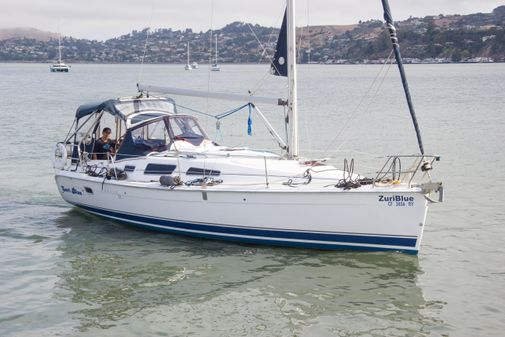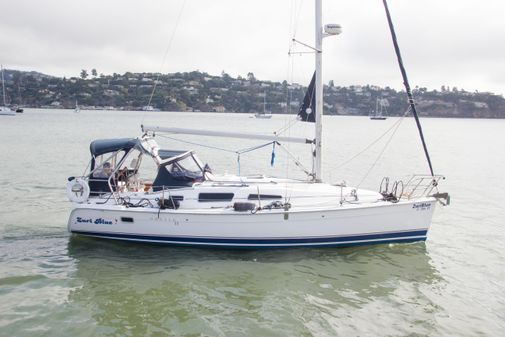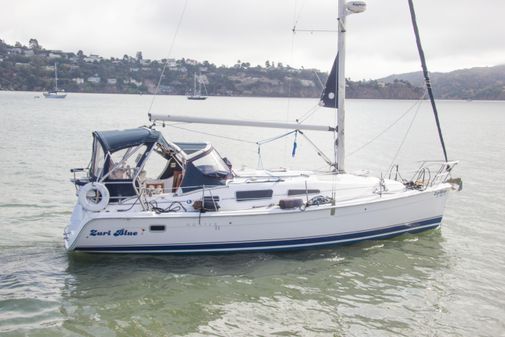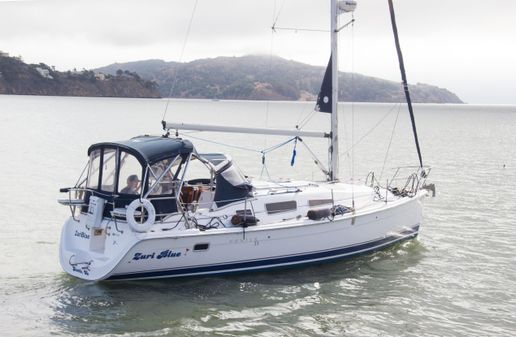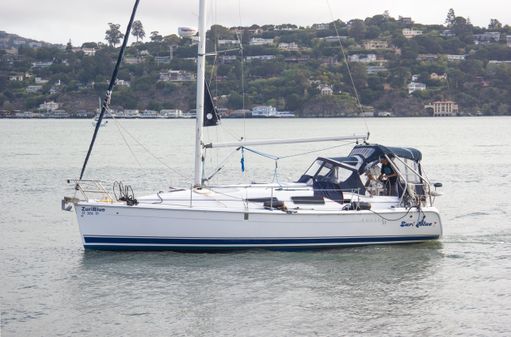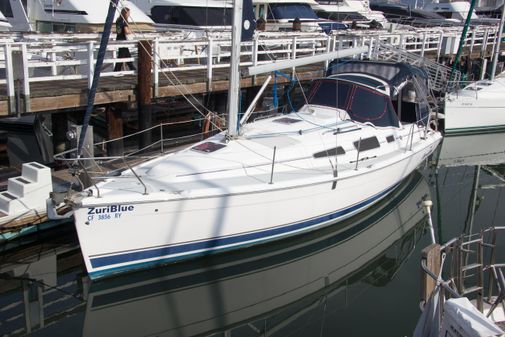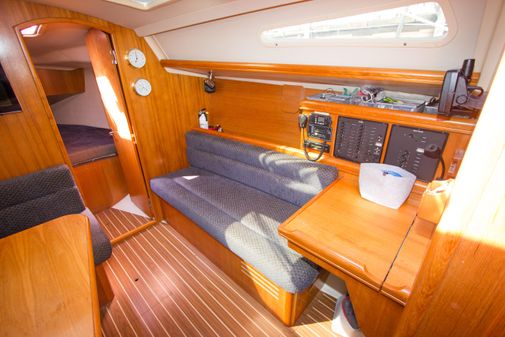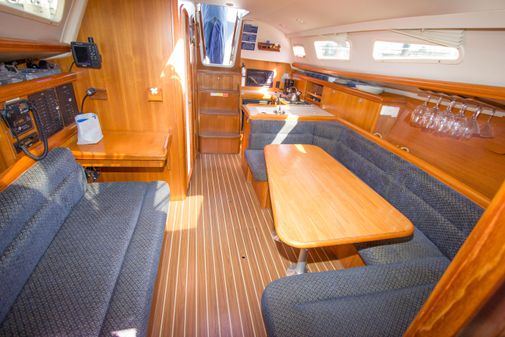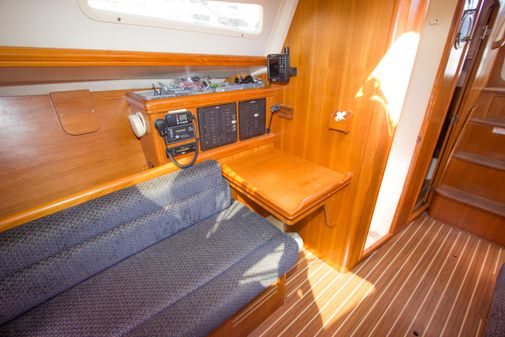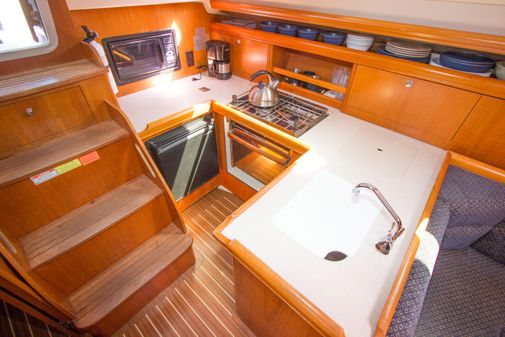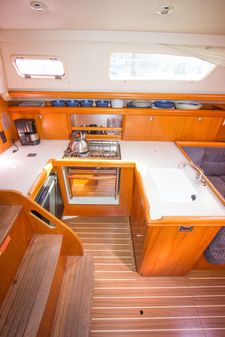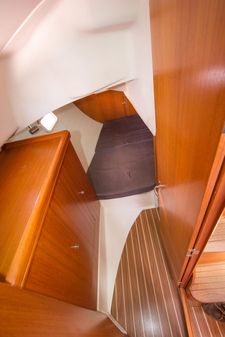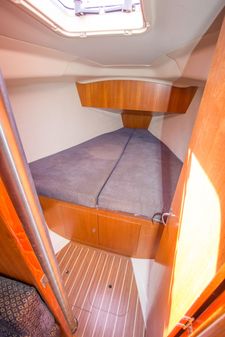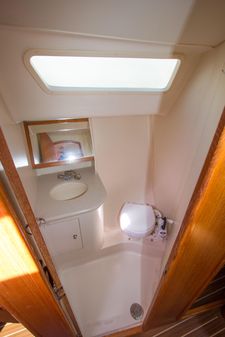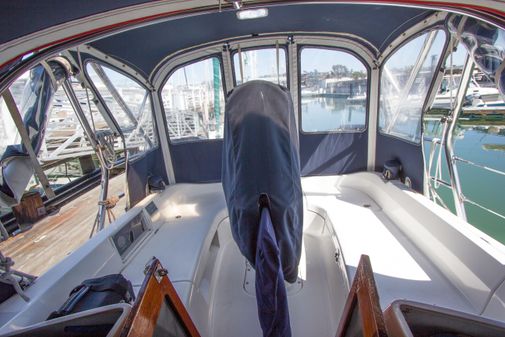Basic Boat Info
Dimensions
Engines / Speed
- Make: Yanmar
- Model: 3YM30
- Fuel: Diesel
- Engine Power: 28hp
- Type: Inboard
- Propeller Type: 2 BladeBronze
- Engine Location: Center
- Drive Type: Direct
- Year: 2005
Tanks
Other
Contact
Office
100 Bay Street
Sausalito, CA, US, 94965
Tel:415-331-6200
The Company offers the details of this vessel in good faith but cannot guarantee or warrant the accuracy of this information nor warrant the condition of the vessel. A buyer should instruct his agents, or his surveyors, to investigate such details as the buyer desires validated. This vessel is offered subject to prior sale, price change, or withdrawal without notice.
Large V shaped berth forward with overhead hatch, hanging locker and built in seat. Step aft to salon with large C-shaped settee and dinette port side with straight settee across starboard.
Contiue aft to C shaped galley port side, centerline companionway aand head starboard. Far aft starboard is master stateroom with queen-size berth set athwartship under the cockpit.
Deep stainless steel sink with hot/cold pressure water (five gal. hot water heater), two burner LPG gimballed stove with oven, built in Tappan microwave, ice box with 12V refrigeration.
Bemis manual pump toilet to holding tank with macerator.
110V AC / 12V DC. Thirty amp shorepower service, two Gp 31 AGM batteries, single Gp. 27 AGM battery, 400W inverter/charger.
Raymarine C80 chartplotter at helm, GarminGPSmap 182C at the helm, Raymarine ST60 wind speed/direction indicator, Raymarine ST60 depth sounder, Icom VHF radio..
Dual AM/FM/CD stereo.
Anodized aluminum Seldon double spreader deck stepped fractional rig mast with B&R backstayless rig, compression post and 1x19 stainless steel standing rigging, aluminum boom with Seldon rigid boom vang, in-mast furling mainsail with mainsheet on stainless steel arch. 110% furling jib on Harken Mk IV rollerfurler, cabintop and inboard jib tracks with adjustable cars, all lines lead aft thru seven rope clutches.
Two #30 self-tailing winches., two #16 self tailing winches.
Solid FRP hull with structural grid reinforcement, balsa cored sides and deck with molded-in non skip walking surfaces, cast iron ballasted fin keel, balanced spade rudder with composite shaft, thru-bolted deck-to-hull joint, step-thru transom with integral swim platform. Hull color is white with dark blue boot strip, rub rail at the shear, Lewmar direct drive steering system.
Stainless steel radar arch supports mainsheet and is incorporated into full isinglass and Sunbrella canvas cockpit enclosure. Stainless steel bow pulpit, stanchions and stern pulpit, double lifelines.
Bruce 33 lb anchor on bow roller with chain and line rode.
Hunter Marine does not boast about building boats the old-fashioned way and the company's brochures don't include pictures of grizzled old salts taking sextant sights. Indeed, few production builders have pursued design innovations as devotedly and as successfully as Hunter. Its boats are unabashedly modern. Purists may scoff but the sailing industry has certainly benefited from Hunter's ongoing development of affordable boats that blend comfort, ease of handling and good performance. Hunter seems determined to make sailing less complicated and more fun. Imagine that.
Not surprisingly, the new Glenn Henderson-designed Hunter 33 combines a host of fresh ideas, both above and below the waterline. The shoal-draft hull shape and fractional rig are efficient through a wide range of wind and sea conditions and the optional all-furling sailplan can be controlled from the cockpit. It's nimble in tight quarters and whether you're ghosting up a channel under main alone or backing into a slip under power, this is often an under-appreciated design feature. From the trademark arch and the B&R rig, to the integrated swimming platform and rakish dark portlights, the Hunter 33 includes the innovations and sleek styling that we've come to expect from one of America's largest builders.
What is surprising about the Hunter 33 is the level of fit and finish. The overall quality is impressive, especially for a boat that can be purchased for less than $100,000. From small but important standard features like all bronze through-hull fittings below the waterline, to construction techniques and materials that include lead keels and sophisticated hull layups, to elegant interior joinerwork, the 33 adds up to a solid value.
I recently joined Hunter Marine's Director of Sales Chip Shea at the Miami Beach Marina. He welcomed me aboard a 33 that just the day before had been on display at the boat show; in fact, the banners were still flapping. I took a moment to view the boat from the dock. I like the look of Henderson's design. The cabintrunk merges gracefully into the foredeck creating a lower, cleaner profile than previous Hunter cruisers. Although the 33 carries its beam well aft, visually the boat is well proportioned.
We dropped the banners, cast off the mooring lines and got under way. The boat cut through the water smartly under power, answering my doubts that the 18-horsepower Yanmar was a little on the small side for a boat that displaces 11,000 pounds. Throttling back, we came onto the wind and set sail. An in-mast furling main is an option, as is a furling boom. The standard main includes single line slab reefing. The furling 110-percent headsail is standard. We used the inboard genoa tracks mounted on the cabintop for tight sheeting angles, hardened the sheets and beat out of Government Cut.
The boat felt solid in the water, and as we pushed through a choppy inlet Shea noted some interesting construction details. The hull is solid laminate below the waterline and balsa-cored above. Hunter uses a modified form of vinylester resin to prevent blistering. The forward sections of the hull, the area most prone to impact, are strengthened with Kevlar. An antimonious lead keel is externally fastened with stainless steel bolts. An extensive bilge grid system breaks up the panel size into small areas, stiffening the hull and supporting the keel loads. The interior components are built in modular fashion and then glassed to the hull. Unlike most builders, Hunter employs an external flange for the hull-and-deck joint. Bonded both with 3M 5200 sealant and through-bolted, this arrangement is strong. However, the joint is vulnerable to impact from docks and pilings. A full vinyl rubrail with stainless insert helps protect the joint.
Clear of the channel we tacked north and fell off onto a close reach. We swapped the headsail leads to the tracks on the deck, opening up the slot and the boat powered up. The true wind hovered around 12 knots and our speed inched toward 7 knots as we clipped along just less than 90 degrees off the apparent wind. The mainsheet controls mounted along the side supports of the arch are surprisingly convenient to use from the helm. The steering console-you can't really call it a pedestal-supports a grabrail and fold-out table. A clever hinged helmsman's seat opens to the transom. The direct drive steering system from Lewmar is designed for low maintenance and offers a nice touch as well. The cockpit is tidy and has a feeling of spaciousness. This is created by the arch, which also houses the mainsheet traveler and controls and the B&R rig that eliminates the backstay. Handy seats tucked into the stern pulpit offer a nice perch while under way. The port side locker is huge, a folded inflatable and an asymmetrical chute will both fit if carefully folded. Halyard stowage wells keep stray lines out of sight.
Giving up the wheel, I made my way forward. The molded nonskid provides good traction and there are stainless grab rails on the aft end of the cabintrunk. It wouldn't be a bad idea to extend these rails a bit farther forward. Deck hardware is top quality with Lewmar winches, Spinlock rope clutches and Harken blocks. The ground tackle arrangement is well thought out with a stout single roller and deep external locker. A windlass is optional. The stanchions are ably supported and the double lifelines have gates where they attach to the arch. The robust stainless steel arch provides a very secure anchor point not only for the lifelines but other gear as well, including a bimini top, antennas, speakers, lights and solar panels. Skylights just aft of the mast flood the interior with light but make working on the deck a bit tricky. Of course all sail controls are led aft so at least in theory you won't be spending much time around the base of the mast anyway.
The shrouds are outboard and the chainplates are bolted through the topsides. This placement doesn't really impact sheeting angles because the fractional 110-percent genoa barely overlaps. Also, with two tracks, sheets can be rigged both inside and outside the shrouds. The Seldon mast is deck stepped and includes a solid vang standard. The double spreaders are swept back in classic B&R fashion, and in practical terms I have found this to be a mixed blessing. Eliminating the backstay allows for a large, powerful full roach mainsail. However, when sailing off the wind the main quickly lays up against the spreaders. A long stretch of broad reaching can cause wear and tear on the sail.
We brought the boat through the wind, easily tacking through 100 degrees apparent and appreciating the easy loads created by the fractional rig and small headsail. Hauling the jib in was a simple affair; the winches were almost unnecessary. I was also impressed with the 33's acceleration, the boat doesn't take long to get up and go. We had a reasonable sea running but there wasn't much tendency for pounding. Henderson's design objective was to produce a boat that is both responsive and forgiving under sail, a tall order that he seems to have achieved. The shoal-draft bulb keel maintains a very low center of gravity and pitching, or what we used to call hobby-horsing, is kept to a minimum by fine bow sections and a long waterline.
After a couple of hours on the water we reached back down the channel and headed for the marina. A swift current runs through the basin and a crosswind made it a bit challenging to back the boat into the slip. After a few tries I managed, which was more a testament to the boat's handling than to my skills.
At this point I dropped below and closely examined the interior. The interior plan includes two private staterooms, a large galley and a comfortable saloon. The aft cabin, accessed from starboard, is considered the master, and with good reason. From the perspective of this cabin it's hard to believe you're on a 33-foot aft cockpit boat. The cabin includes a large double berth (almost a queen!), a hanging locker and most importantly, plenty of elbowroom. The fully enclosed head is just forward of the aft cabin. Fiberglass lined for easy cleanup, the small basin is set in a Corian countertop.
The galley is opposite the head, immediately to port of the companionway steps. Again, the amount of space is impressive, emphasized by clever features. Plenty of counter space surrounds a large single stainless steel sink, which incidentally is more practical than two small sinks. Instead of taking up space with a full cooker, Hunter has opted for a two-burner range top with storage underneath. The standard issue microwave serves as the oven. A 12-volt front-loading refrigerator and small freezer frees up the large icebox for dry storage. Hot and cold pressure water is standard and the 50-gallon fresh water capacity is adequate.
The saloon includes a U-shaped settee draped around a large teak table to port and straight settee to starboard. As noted earlier, skylights let in natural light but when you want privacy, they're quickly closed off with accordion shades. Ventilation is provided by three overhead hatches and two opening portlights. A few 12-volt fans will be a necessity for hot summer nights. The dinette converts to a double berth while the foot of the starboard settee serves as the seat for the small, aft facing chart table. The AC/DC electrical panel is located here, as well as open panels for radios and repeaters. AC plugs are located in each cabin and a 30-amp battery charger is standard. The forward stateroom also features a large double berth and full hanging locker.
The Hunter 33, with its impressive design features, upgraded quality construction, brand name hardware and comprehensive standard gear package, is sure to become another bestseller for one of America's most consistent builders.
Sailing magazine (August 7, 2004)
The Company offers the details of this vessel in good faith but cannot guarantee or warrant the accuracy of this information nor warrant the condition of the vessel. A buyer should instruct his agents, or his surveyors, to investigate such details as the buyer desires validated. This vessel is offered subject to prior sale, price change, or withdrawal without notice.
